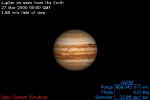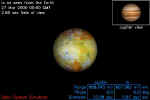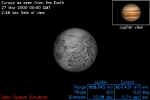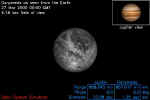|












| |
Jupiter
The Jovian Giant
|
| |
Jupiter is an easy planet to find and observe, but I am
always fascinating watching its moons in orbit.
|
| |
 Jupiter is the largest planet in the solar system. It is 11
times the diameter of the Earth. It is also 3 times brighter than the brightest
star visible to us, which is Sirius. This makes it a magnitude of -2.5. With a
small telescope, you can see light and dark colored bands across the planet. The
number of bands you can see depends on how close Jupiter is to Earth at the time
and also how stable the atmosphere is when you are viewing it. In other words,
how much humidity is in the air. Jupiter is one of the Jovian planets. All
Jovian planets are made up entirely of gas. With a good scope you may also see a
large reddish region on the planet known as the Great Red Spot (GRS), which is about
18,000 miles in size. It is a giant storm within Jupiter's cloud system. Jupiter
also has four bright moons sometimes referred to as satellites. Their names are,
Io, Europa, Ganymede, and Callisto. You may also hear them referred to as
"Galilean Satellites" or "Galilean Moons." This is because they were discovered by
Galileo. Ganymede is the largest of the 4 moons. It has the largest surface
diameter of any moon in the solar system. It may contain water and ice
surrounded by a core of rock. Io is the most active moon in the solar system. It
is covered with volcano's, of which 10 are currently erupting. Europa is
believed to be completely covered with ice. Callisto is covered with craters. If
you observe Jupiter and its moons nightly you will see that they change
positions. See the illustration below for their current positions Jupiter is the largest planet in the solar system. It is 11
times the diameter of the Earth. It is also 3 times brighter than the brightest
star visible to us, which is Sirius. This makes it a magnitude of -2.5. With a
small telescope, you can see light and dark colored bands across the planet. The
number of bands you can see depends on how close Jupiter is to Earth at the time
and also how stable the atmosphere is when you are viewing it. In other words,
how much humidity is in the air. Jupiter is one of the Jovian planets. All
Jovian planets are made up entirely of gas. With a good scope you may also see a
large reddish region on the planet known as the Great Red Spot (GRS), which is about
18,000 miles in size. It is a giant storm within Jupiter's cloud system. Jupiter
also has four bright moons sometimes referred to as satellites. Their names are,
Io, Europa, Ganymede, and Callisto. You may also hear them referred to as
"Galilean Satellites" or "Galilean Moons." This is because they were discovered by
Galileo. Ganymede is the largest of the 4 moons. It has the largest surface
diameter of any moon in the solar system. It may contain water and ice
surrounded by a core of rock. Io is the most active moon in the solar system. It
is covered with volcano's, of which 10 are currently erupting. Europa is
believed to be completely covered with ice. Callisto is covered with craters. If
you observe Jupiter and its moons nightly you will see that they change
positions. See the illustration below for their current positions |
| |
 |
"Image
courtesy Jet Propulsion Laboratory.
Copyright (c) California Institute of Technology, Pasadena, CA. All rights
reserved."
[click on thumbnail for larger image]
|
Jupiter Facts
|
Distance from Earth
|
5.2 AU |
Apparent Magnitude
|
-1.2 to -2.5 |
Mass
|
318 x Earth's mass
1.9 x 1027 kg |
Jupiter Day
|
9.84 hrs at equator
9.93 hrs at poles |
Radius
|
11.2 x Earth's radius
142,800 km |
Jupiter Year
|
11.86 Earth years |
Apparent Size
|
33-50 arcsecs |
|
|
|
|
The Galilean Moons
|
Io
|
Europa
|

|

|
| |
|
Ganymede
|
Callisto
|
 |
 |
"Images
courtesy Jet Propulsion Laboratory.
Copyright (c) California Institute of Technology, Pasadena, CA. All rights
reserved."
[click on thumbnail for larger image]
|
Links
|
| |
|
|
 The Pages of The Gray Wizard
The Pages of The Gray Wizard